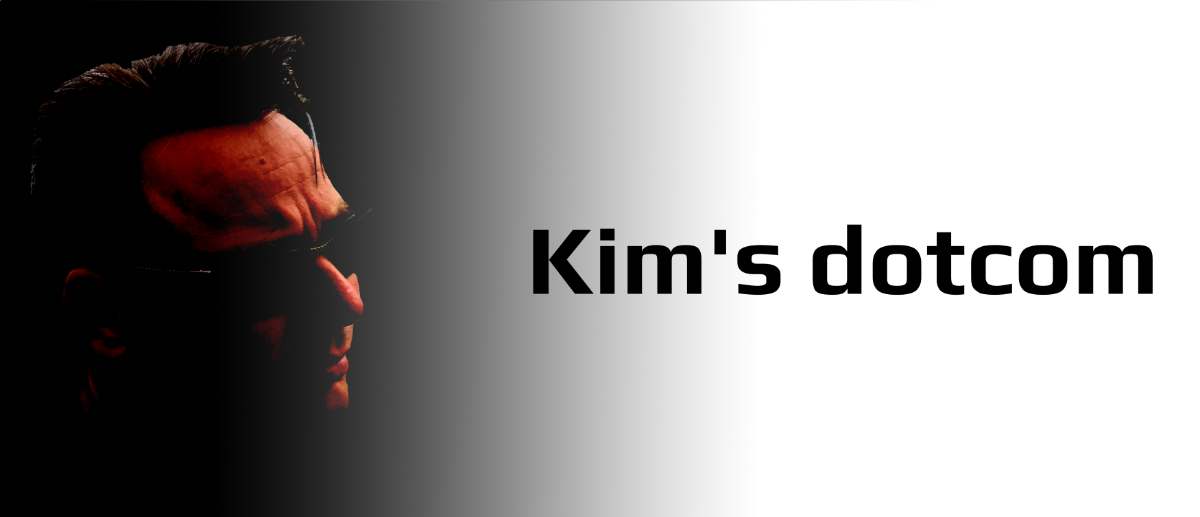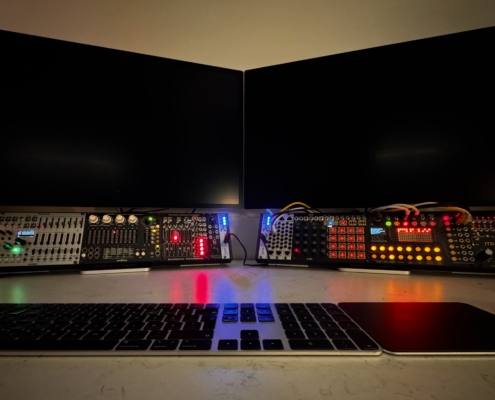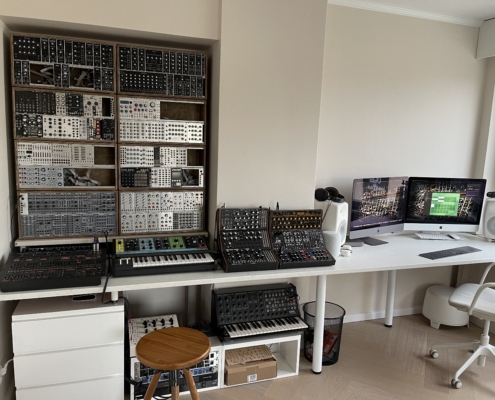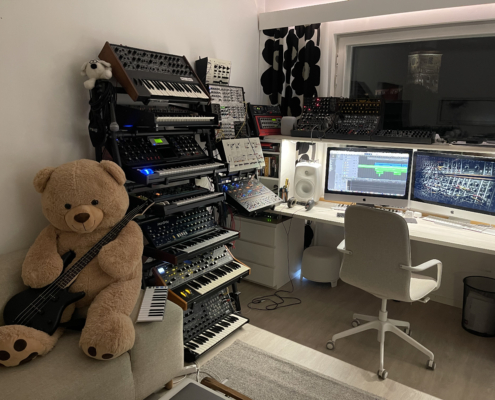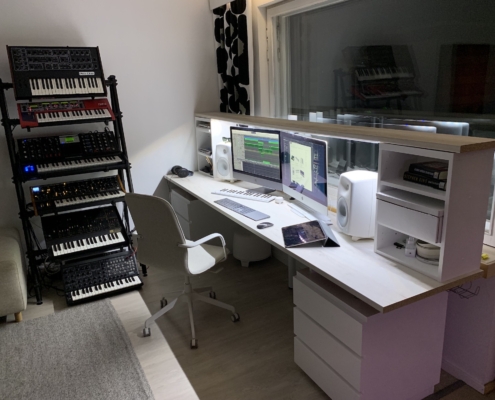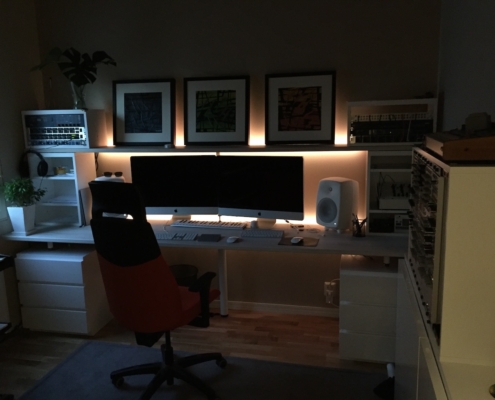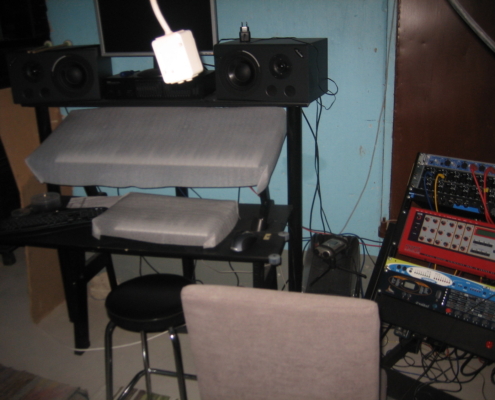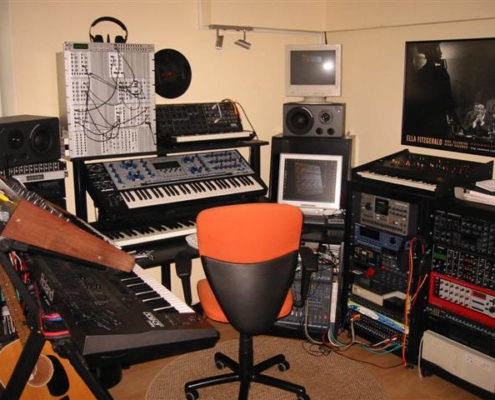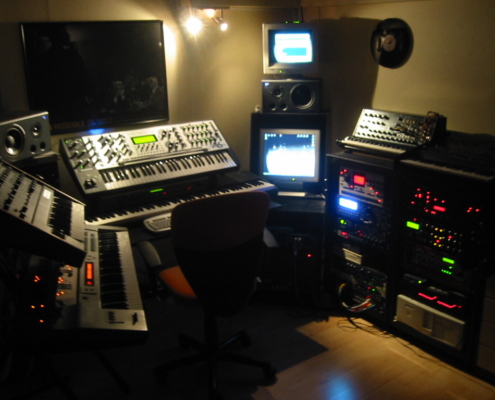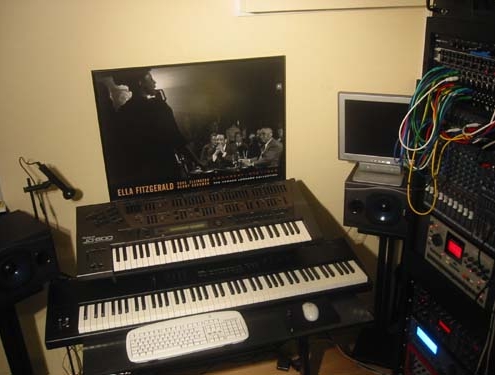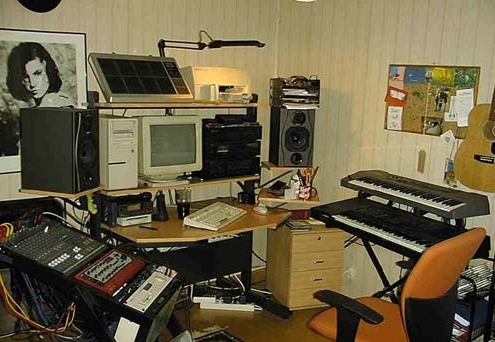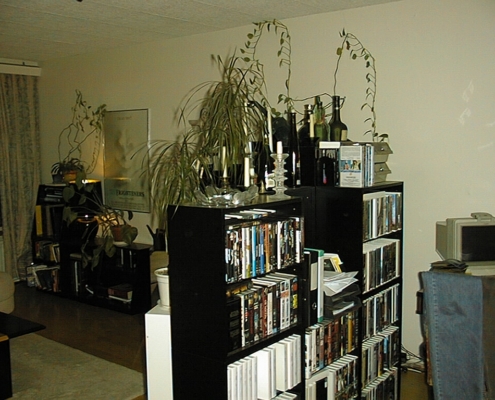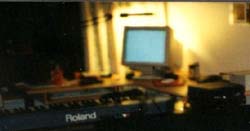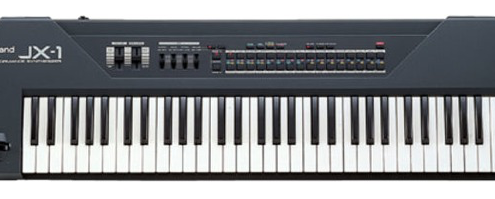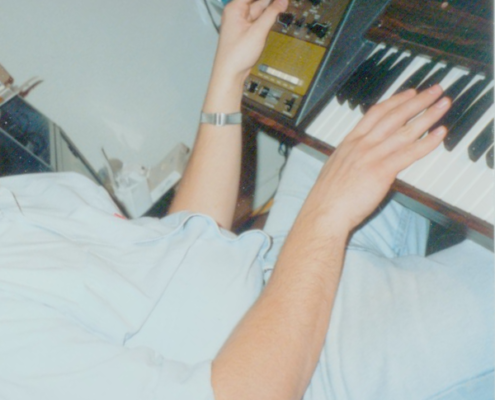The studio evolves hand in hand with the music hobby itself. There are some practical issues with home studios, mainly how to get everything placed as conveniently as possible, using a minimum amount of space. These two goals are more or less mutually exclusive. Also, some might argue that soft synths are the most convenient way to set up any studio, and that is a valid point, but as I am a hardware person by nature, I’ll just ignore that point for now.
So please follow me and the ebbs and tides of gear flowing in and out of my studio.
Things kinda got out of hand. Now I’ve got enough Eurorack modules to keep me learning for years. We all know, though, that there will be more, but I’m seriously trying to cut down. Also sold a lot of stuff I haven’t used, so that’s good. Still have the studio split in two, with the keyboards in the bedroom and the living room being the main studio until one of the other rooms becomes available, which won’t happen for a couple of years.
Upgraded my Mac to a Mac Studio Ultra M1 in late 2022 as well, and things are smooooooth!


As of the beginning of 2025, I will continue finalising the 11 remaining Darwin’s Mistake (the band name) songs and try go get the album (Humanity) published at some point. Because we all love a release party.
Musical Output From This Period
During more or less the entire 2024 I was working to finish the first song for our (the bro’ and me) first album. Also did a collaboration with my cousin, but other than that, I’ve mainly been building my studio during this period.
Time to move, even 150 meters appears to be quite the chore. Double the floor space, but the studio still didn’t get its own room.
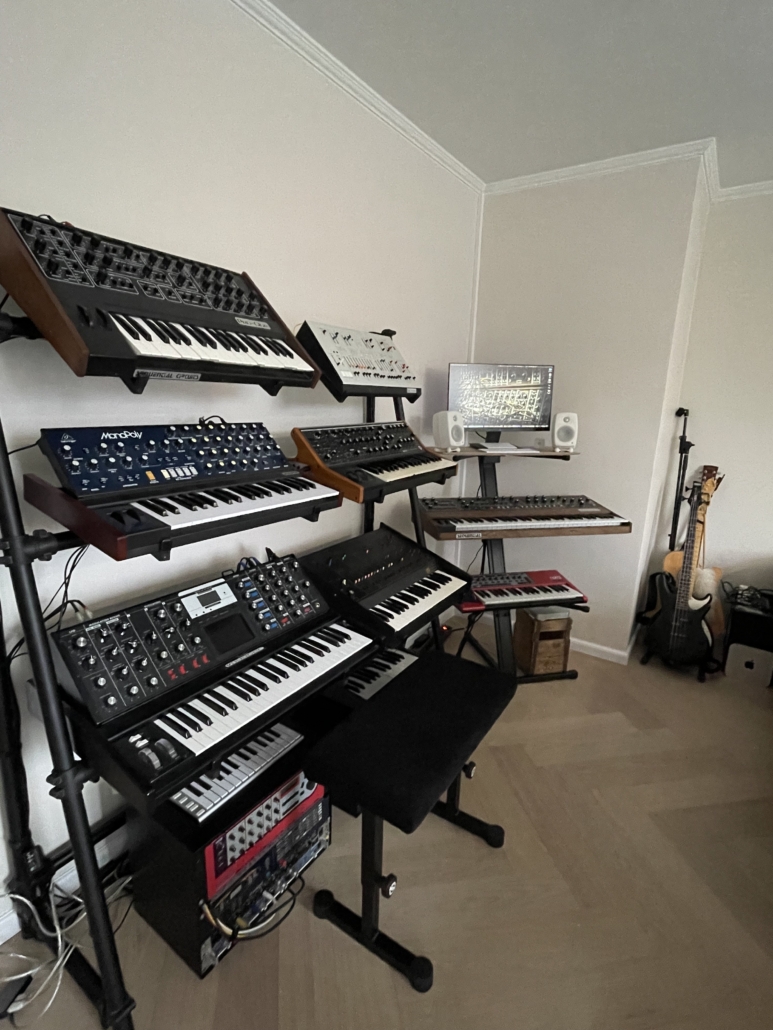
This time I actually opted for a split studio, half of the stuff in the livingroom and the other half in the bedroom. The livingroom has the modular stuff, and the bedroom has the keyboards. When I make music, I need to connect a long firewire and a long USB cable from the bedroom to the hub in the livingroom, and then everything is peaches. In the bedroom I have a trusty Mac Mini from 2012 from where I initiate a Screen Sharing session to my DAW in the livingroom, and everything is doubly peaches. It just works. Anything else would suck, as it took me two months to get everything up & running.
It’s not actually perfect; perfect would be one long permanent cable between the rooms. Have to figure out something…
First time in many years I’ve bought anything new. Moog and Behringer more or less jumped me. 4 of the first and 6 of the latter plus the new ARP Odyssey meant some rearranging had to happen.
I expanded the Jasper’s rack to stand partially on my desk, and crammed as many keyboards on top of each other as humanly possible. The end result is not particularly ergonomic, as I actually need to do some diving to get sounds done. I can slide a synth I’m working with a bit outwards from the stand so I can get to all of the knobs, and I guess this is as good a compromise as any. The G2 is entirely hidden from view behind the MS-20, but that’s the one I don’t need to actually touch.
Just a couple of more modules or eurorack thingies and I won’t be able to see out through my window anymore, which would be a shame. Time for some serious introspection and prioritisation, then. Along the lines of less-is-more, maybe? Or maybe I should move…
Musical Output From This Period
A really positive thing: I’ve been quite productive and managed to finish a shitload of songs that I’m making with my Bro. Just one more to go and we’re finished. Not socially, but from the project’s viewpoint.
Another huge restructuring. Of my entire life, no less. But back on topic. This time part of the studio will live in my new living room, and the rest of it will be in my bedroom.

I’ve been thinking. If I could find a long UBS-C / Thunderbolt cable (14 meters would do), I could move all the synths to the bedroom and have a livingroom-y living room, but 500+ UKP for an optical cable is not really worth it. I think it would be quite a nice setup: I could control the synths with the Arturia controller from my DAW, and should I want to play around with the synths, they would all be within reach in the bedroom. From the bedroom I could control my DAW with the Logic remote control app on the iPad. I think it would work really well. Let’s see.
In the meantime, I’m happy with having all my keyboard synths right next to me. As of now, the NM, Pulse and Kurzweil are not yet set up. Makes no sense, really, to do that, as there’s no connection to the DAW. So I might need to relocate them to the living room at some point.
Playing with the Frank Jr / SEM / MiniBrute -combination works quite well, even if they are isolated. If I need to record them, I can use a long audio cable and play by hand.
Didn’t really get any music done during this period.
Time to ditch some gear! In the end, I did not sell nearly as much as I initially thought I would, but still a substantial amount. I used some of the money to get a new Eurorack going. I also made what was to be the last synth purchase for several years and got the Moog Sub 37. Once I noticed that immediately when I had placed the order I started thinking about what synth I should get next, I realized I was on the wrong path. Didn’t buy another synth during this period, and I’m proud of it. I have been interested in many new synths, but I haven’t given in to the craving. It is really a fantastic time to be a synth fan, as everybody is releasing affordable analog synths nowadays, and the Euro format is thriving.
Once Frank The Modular was out of the way, I could rebuild the studio room’s floor, ceiling and walls. Out with the huge black Muurame bookshelf and in with a wide white desk instead. The keyboards would be in two different keyboard stands behind my back, out of reach, so I got a slim CME XKey 37 MIDI keyboard to punch in notes with. The modular (Frank Junior) would be on my right. Quite a different studio compared to pre-Judgment day. Also got a pair of Genelecs (including subwoofer).
One notable thing I did was get another 27″ iMac to use as a second screen (if my gf wasn’t at the table, in which case it would be her workstation). Two of those screens combined with the Mac’s way of handling virtual desktops is just pure bliss to work with.
I replaced the CME with an Arturia KeyLab 49 with sliders and stuff, but it did not make much of a difference. At some point I traded something to an Arturia BeatStep, but I haven’t really used it for anything. So, a pretty quiet period, hardware wise.
Except that I upgraded my 2013 iMac to the 10-core iMac Pro model in the summer of 2018. It’s clearly overkill for music making, but for 3D animation it’s totally appropriate.
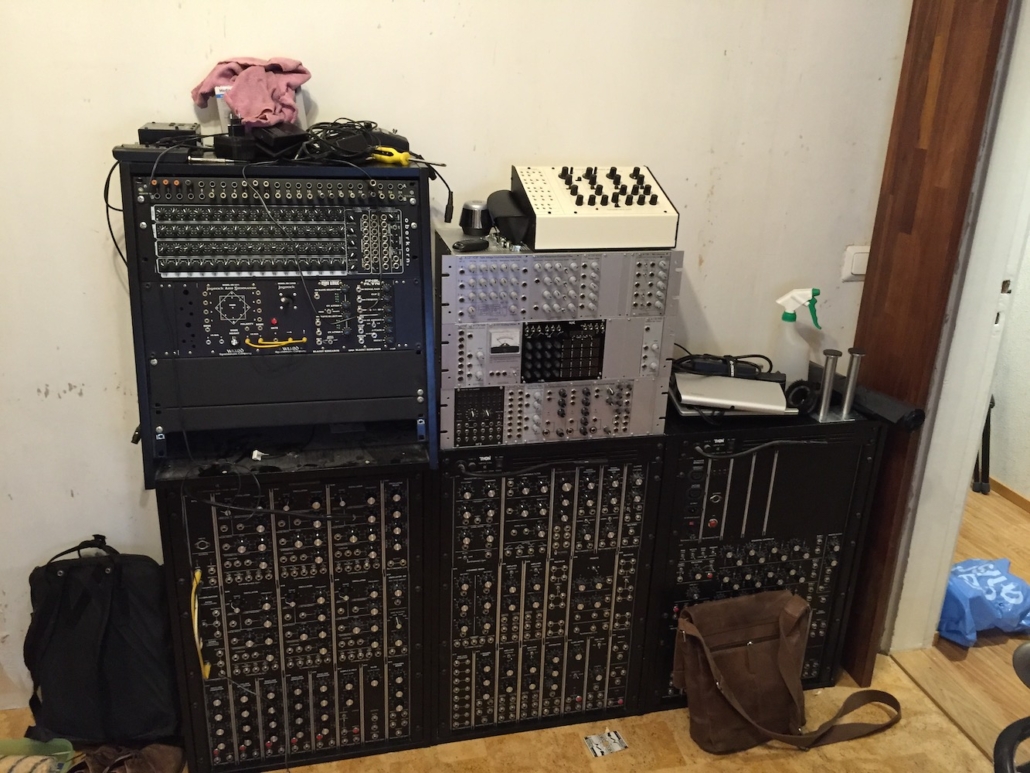
Frank is going out 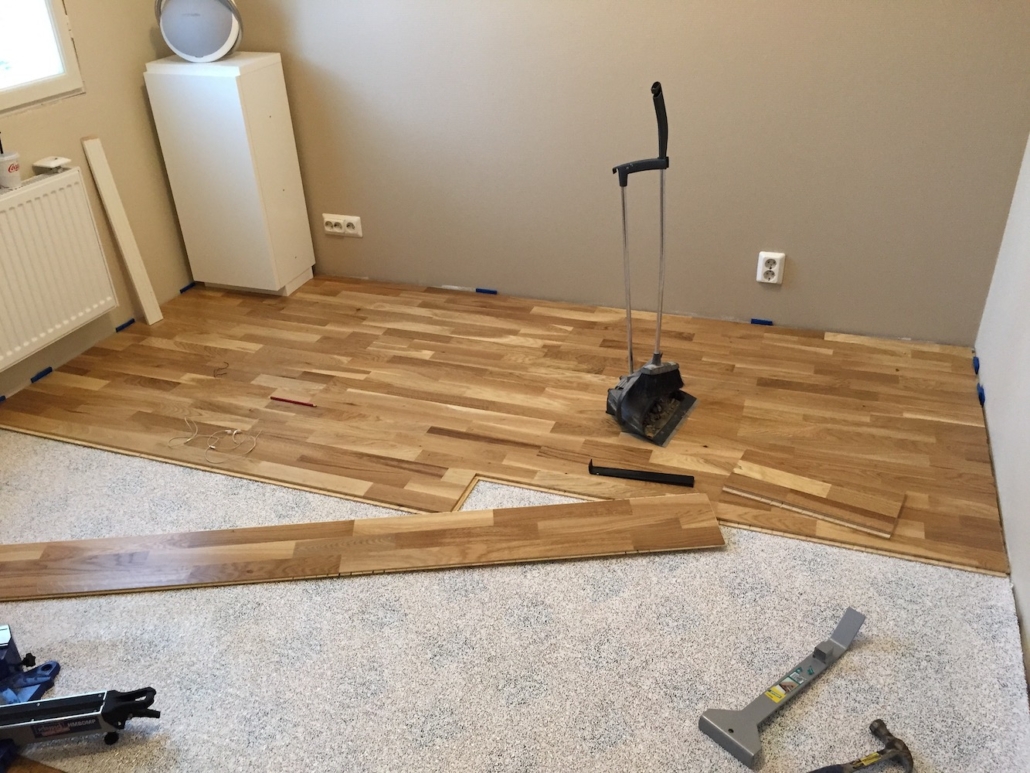
Groundbreaking (?) work post-Frank 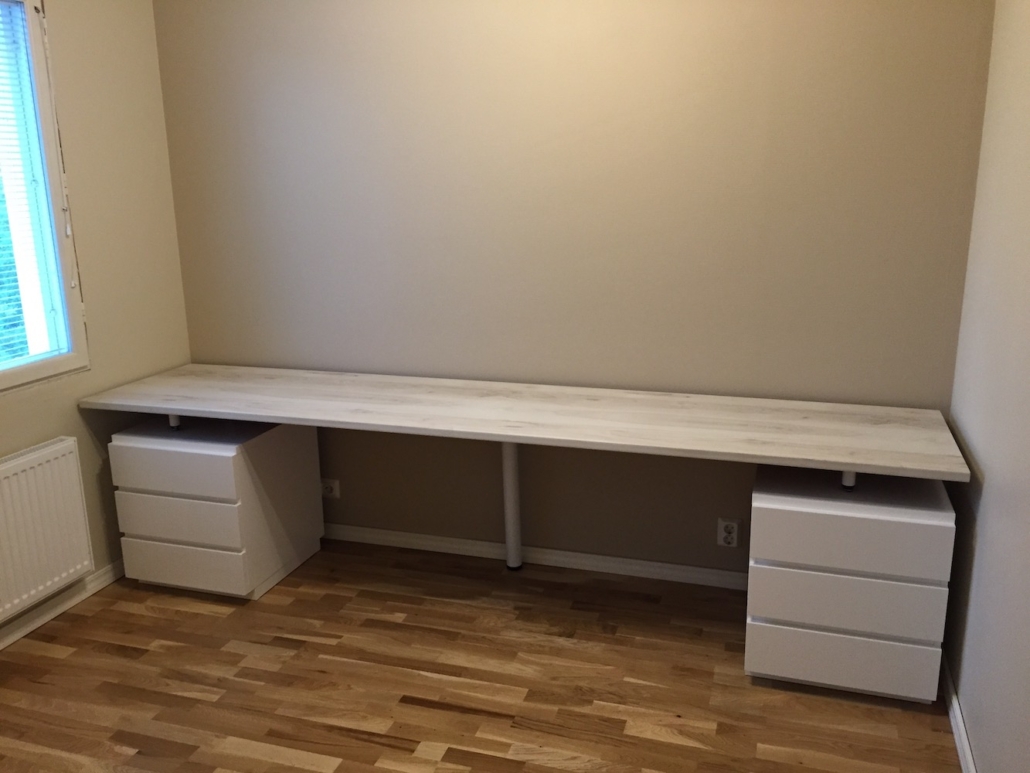
Perfect fit 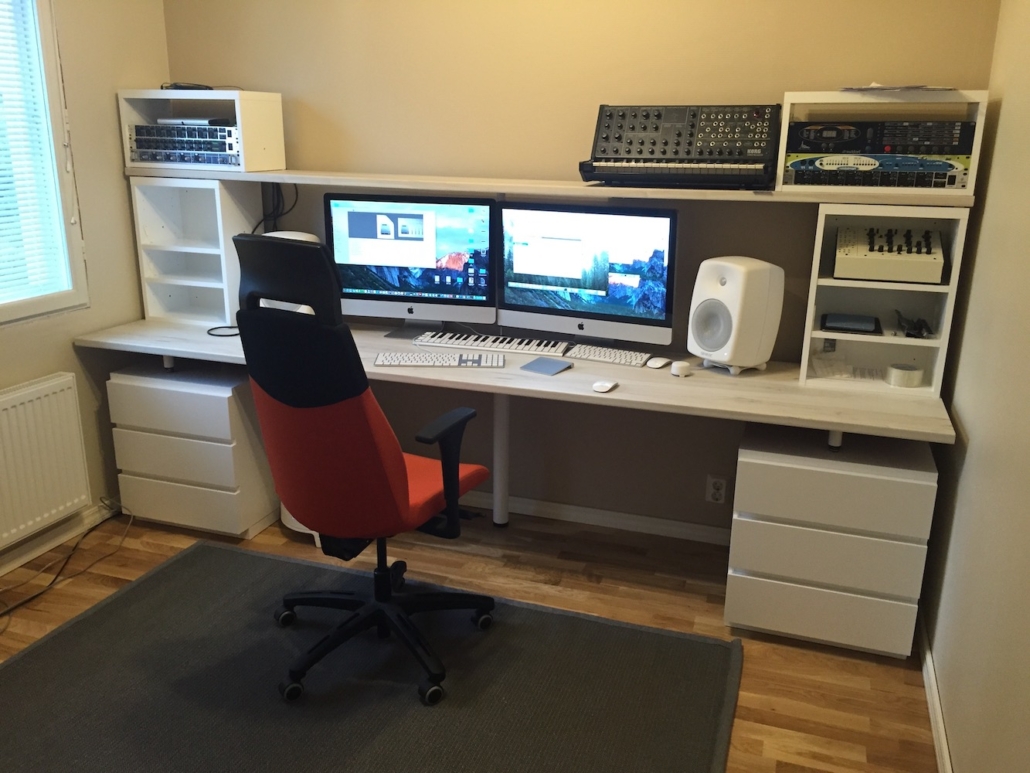
Early demo 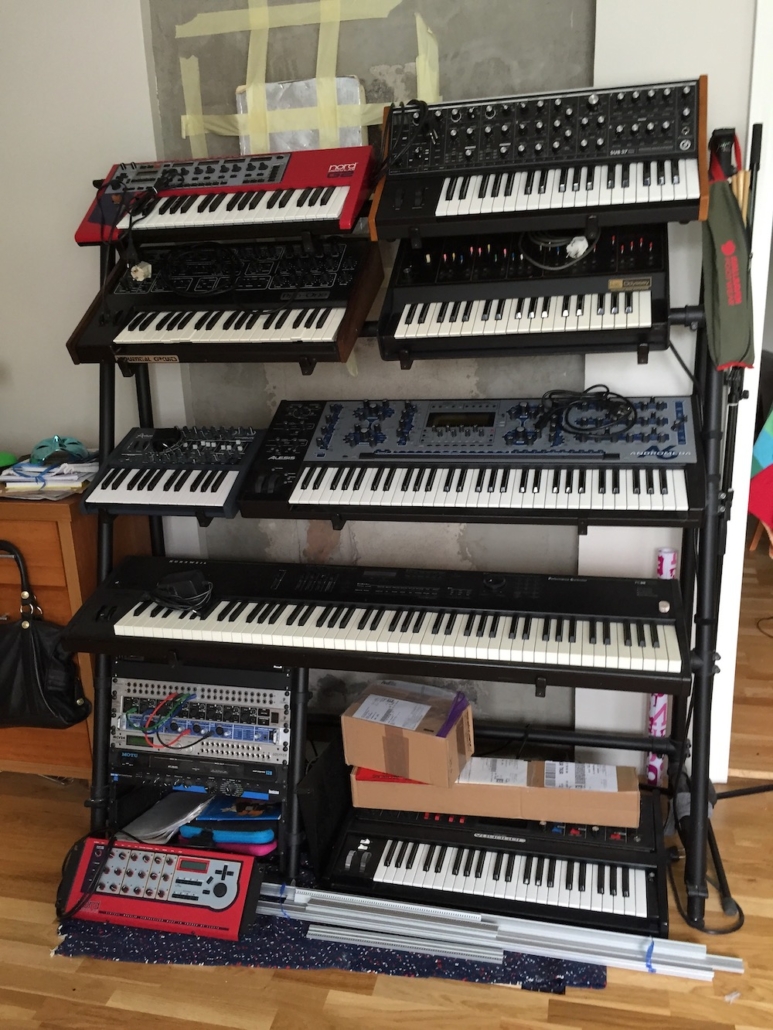
Waiting for relocation back to the studio 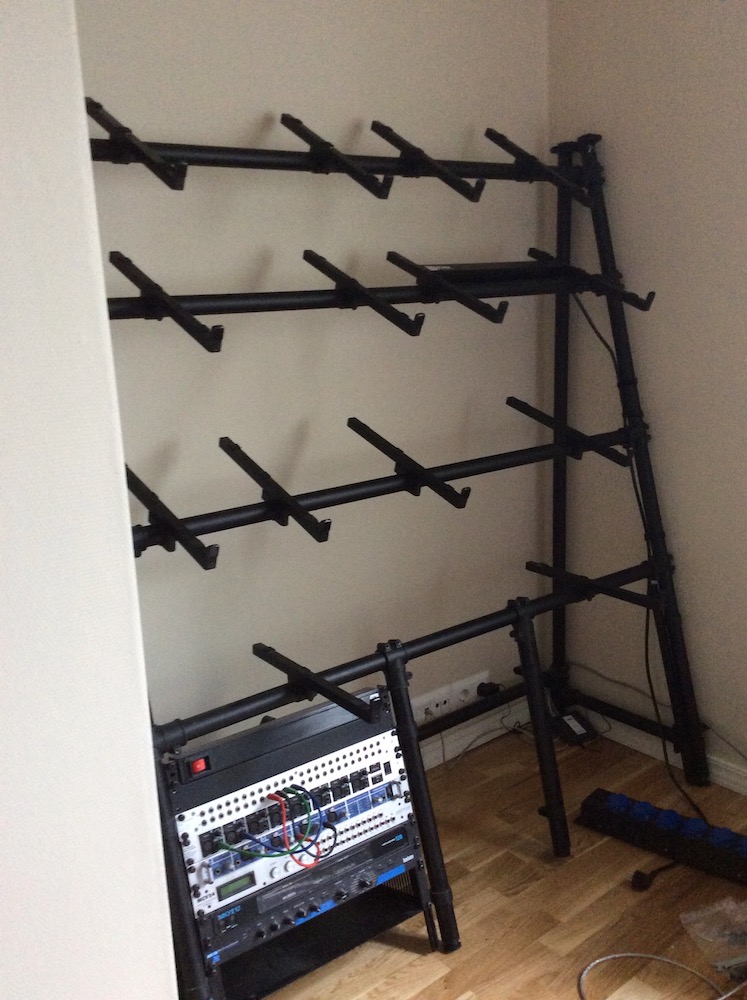
Getting there 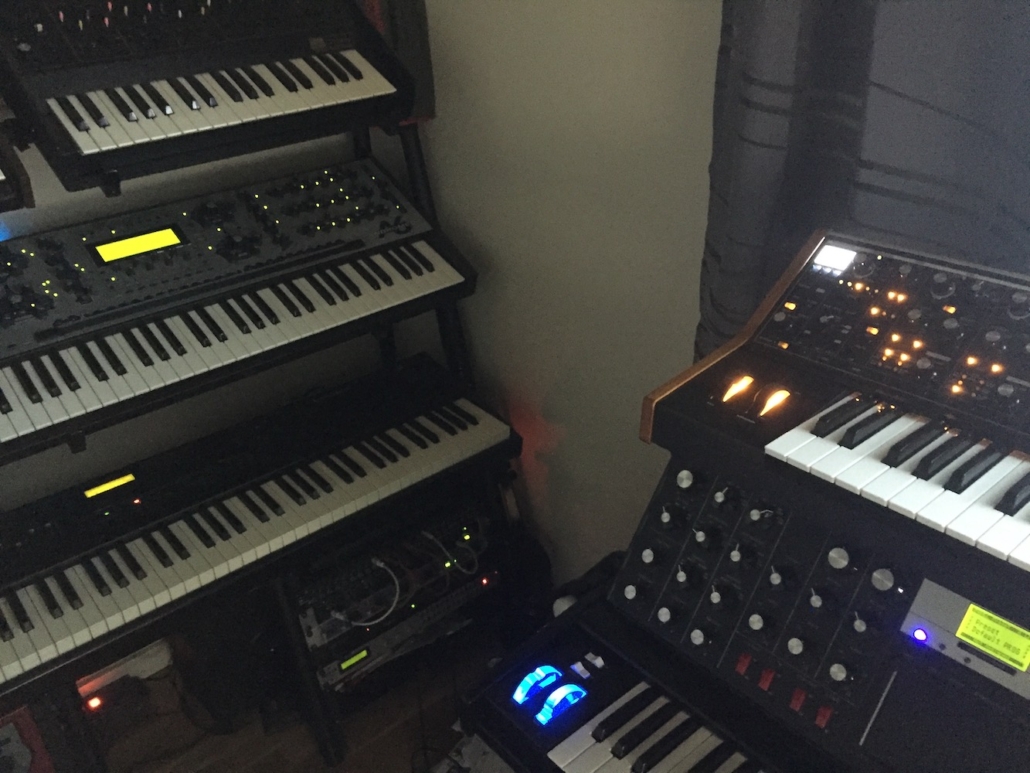
The Synth Corner 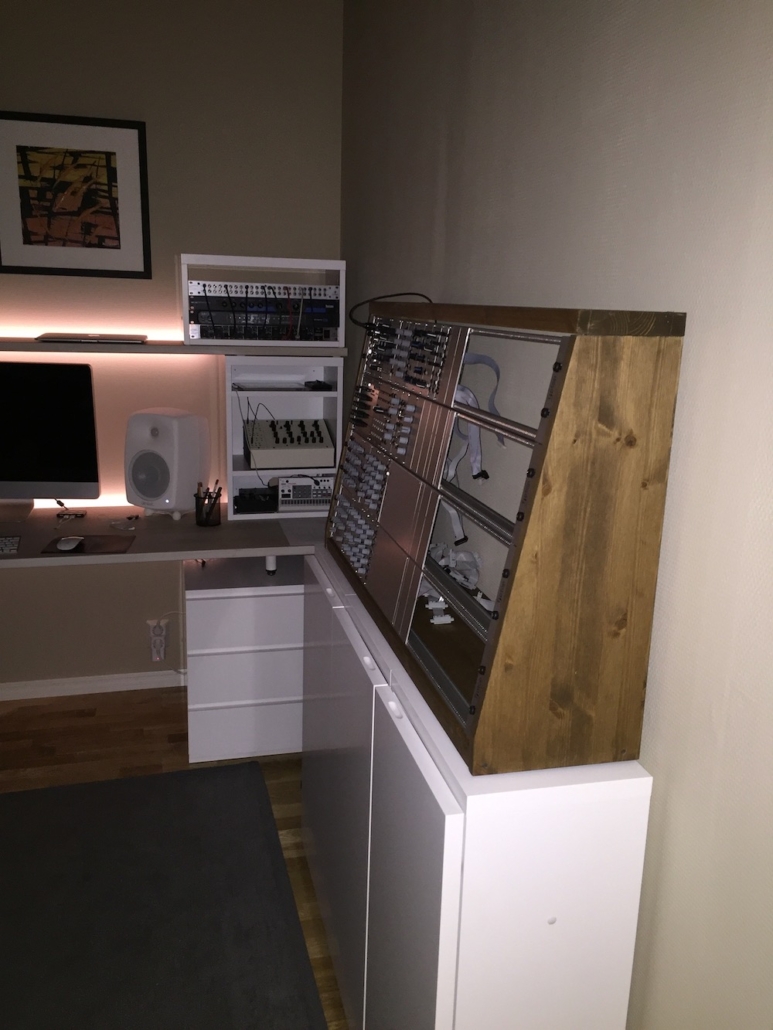
Frank Jr 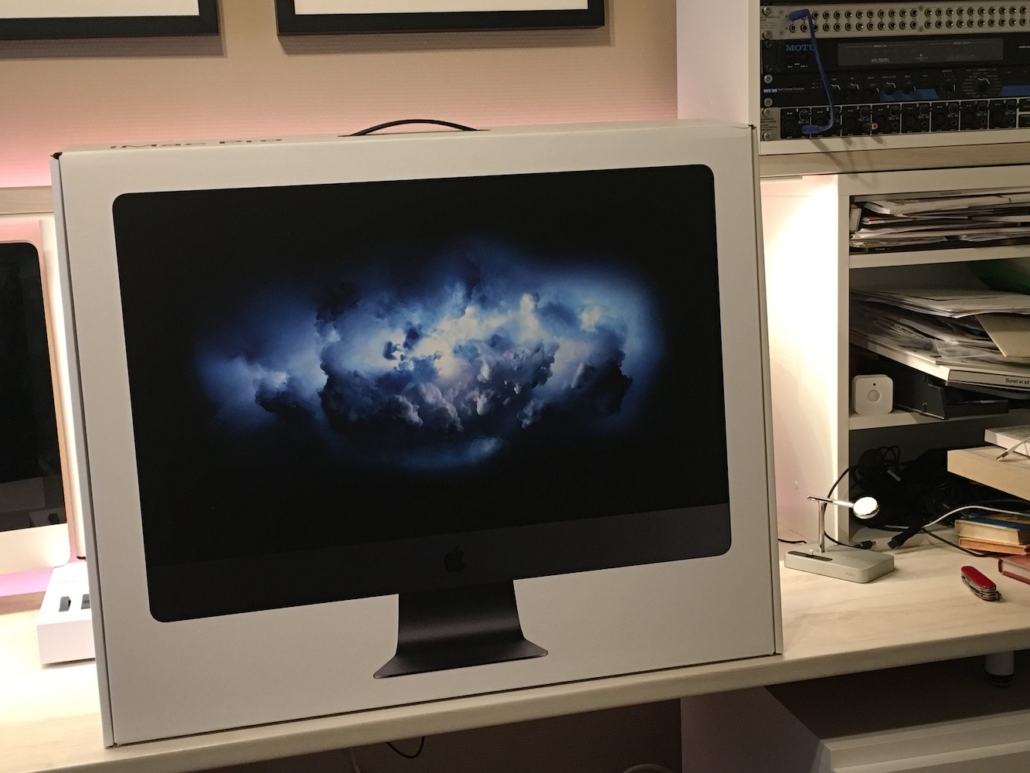
The new workhorse
Musical Output From This Period
In the same instant my head hit the pillow when I went to bed at 1 am on February 20:th 2015, a thought came to me from out of the blue: What if I sold everything?
I was so shocked that I lay awake the entire night thinking about letting everything go, the pros and the cons of it all, and what I would possibly keep (I hadn’t given up on making music, just considered a fresh start). When my gf got out of bed in the morning at 7 o’clock, I did the same, went downstairs to the studio and had a long look at my gear, and nodded. Yeah, I could sell almost everything.
I documented my original plan in an email to the trusted Music Bar mailing list like this:
Hi guys!
I didn’t sleep one single minute last night. When my head hit the pillow some 7 hours ago I for some inexplicable reason decided I would sell pretty much everything in my studio except:
Kurzweil PC-88 keyboard (for the kids to practise their stuff)Nord Modular G2 (just can’t let that one go)Waldorf Pulse (so much balls that it simply won’t fit out the door)Oberkorn sequencerOberheim SEM Patch Bay9U of empty Doepfer cases
And:
Moog Sub 37 (going to buy)Prophet 6 (will probably buy)Korg MS-20, the kit thingy (may buy)alternatively I won’t sell the original MS-20
Then I’ll slowly expand the Euro stuff focusing on sequencing and interesting stuff, and otherwise go soft / iPad. And try to keep it simple.
A strange but somewhat liberating feeling…
Cheers,
Me
A discussion took place. I had something more to say:
Well, I’m actually quite happy with all my stuff, and I am sure I will miss some of it, but there’s definitely some redundancy. Also, as an example, I probably only use 5% of the Andromeda’s capabilities, so a Prophet 6 simply makes more sense to me. I don’t like menus on synths. My current modular is extremely basic, and for all practical purposes the Kurz 2600R is just a preset box. It’s quite the chore to program. I don’t like menus on synths. Also have a couple of other ones which I like but really haven’t used for anything (MEK, Blofeld). The Jomox is also way underused.
The Pro One I think is similar enough to the Prophet 6 (well, it covers similar ground, I guess), the Voyager must have something in common with the Sub 37, and the Odyssey is being resurrected, so I don’t feel I’m losing anything neither completely nor for forever.
This really feels like a new beginning :-)
Sold the MEK and Monotribe today, so it has started. Wish me luck :-)
Funny how things change!
Once I had properly settled in, it was time to arrange some hardware. I built a ceiling-high and wall-wide monster out of my Muurame modular bookshelf and filled it with everything rackmountable. It was a sight to behold. Every single person who entered the room had something to say about it. Also, if one kept jumping just ever so lightly on the floor in front of it, it would make quite a dangerous-feeling wavelike movement. I don’t think it actually could have tipped over, though, as it was so close to the ceiling. Given its size, it was pretty stationary, but everything else I moved around the room several times during this period, depending on locations of stacks of floorboards and such.
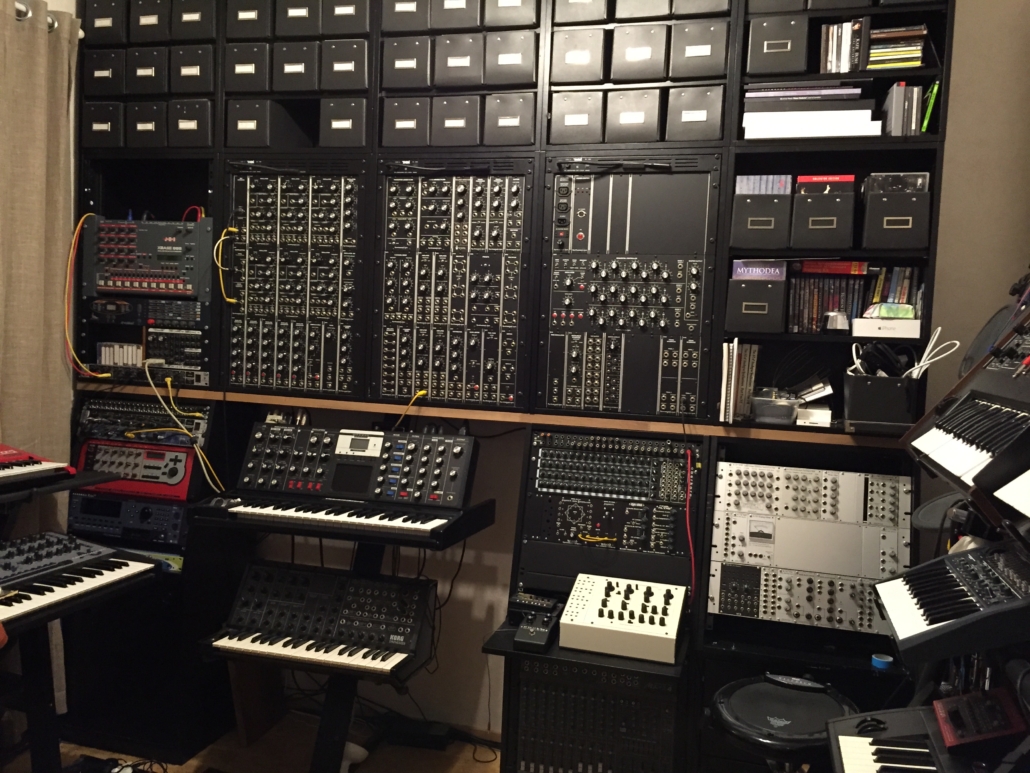
I was now seriously into analog sequencing and modular synthesis. It was so much fun, and had literally endless possibilities. I could patch all night long just for the fun of it. Did get something recorded occasionally as well. There were quite interesting analog sequencers available, and I envisioned having an entire rack of just analog sequencers. All those blinking lights were so soothing…
Most of my acquisitions during this period would fit into either of two categories: anything that could be patched into the modular, and then everything else. Korg were releasing a bunch of small devices, so I just had to try those out. Korg would follow up and put out quite interesting products during the following years.

I constantly thought I had too few synths. Stuff I bought during these years were the wonderful Nord Modular G2 (I got the last one in Europe!), Nord Drum + pads, Oberheim SEM Patch Panel, loads of Euro- and Dotcom-compatible modules, Arturia Minibrute, Oberkorn analog sequencer, Korg Wavedrum, Waldorf Blofeld, Korg Monotribe, Korg Volca Sampler and the MonoEvolver Keys. Insane, really.
To be fair, I also sold some stuff, like the JD-800. Didn’t really use it at all, so it just had to go.
I also expanded beyond electronics and got an electric violin, as I was making a cover of Ultravox’ Mr X. You can’t do a Mr X cover without a violin.
Again I ran out of audio ports. I got myself another RME FireFace 800 plus one additional Behringer ADA8000. With what I already had, that’s a shitload of audio channels. Interestingly, when I was shopping for another audio interface I tried the cheaper ones first, as the FF800 was far from cheap, but Windows couldn’t handle multiple audio interfaces! You could just have one ASIO device at a time. Uhhhhh…. The only reason I could have two FF800’s was that they themselves could be chained together, and their driver could handle the situation.
Also, my trusted 8×8 MIDI interface broke down, and I had to get 2 new interfaces to cover everything. Things sure were simpler before.
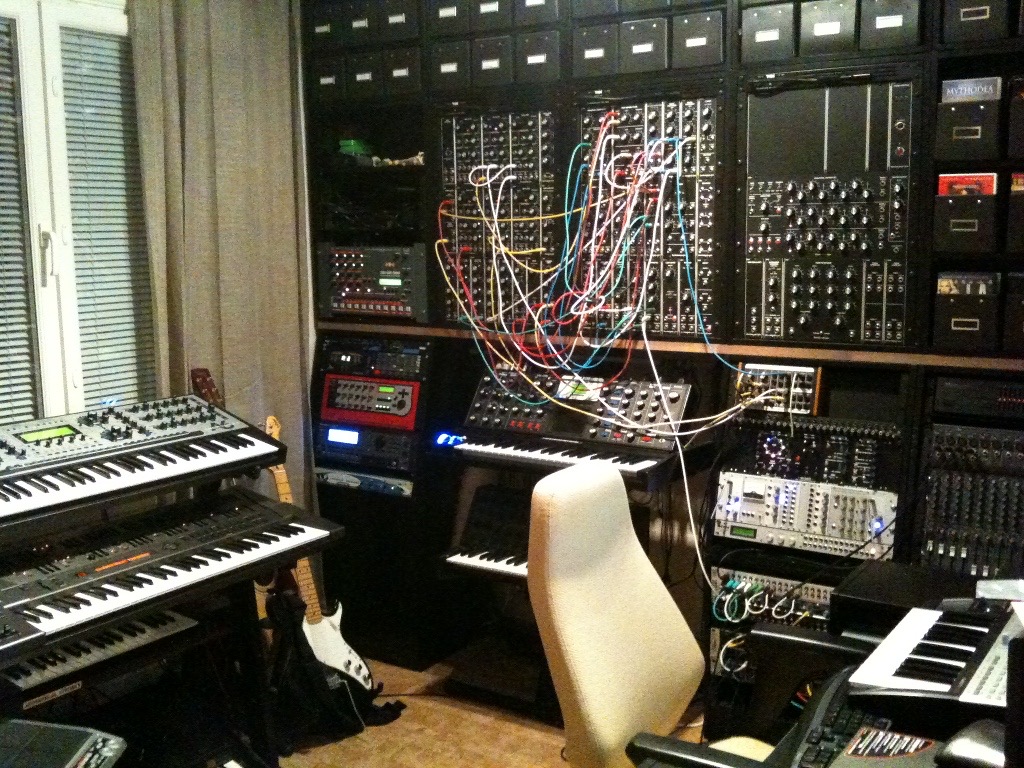
‘Ghetti 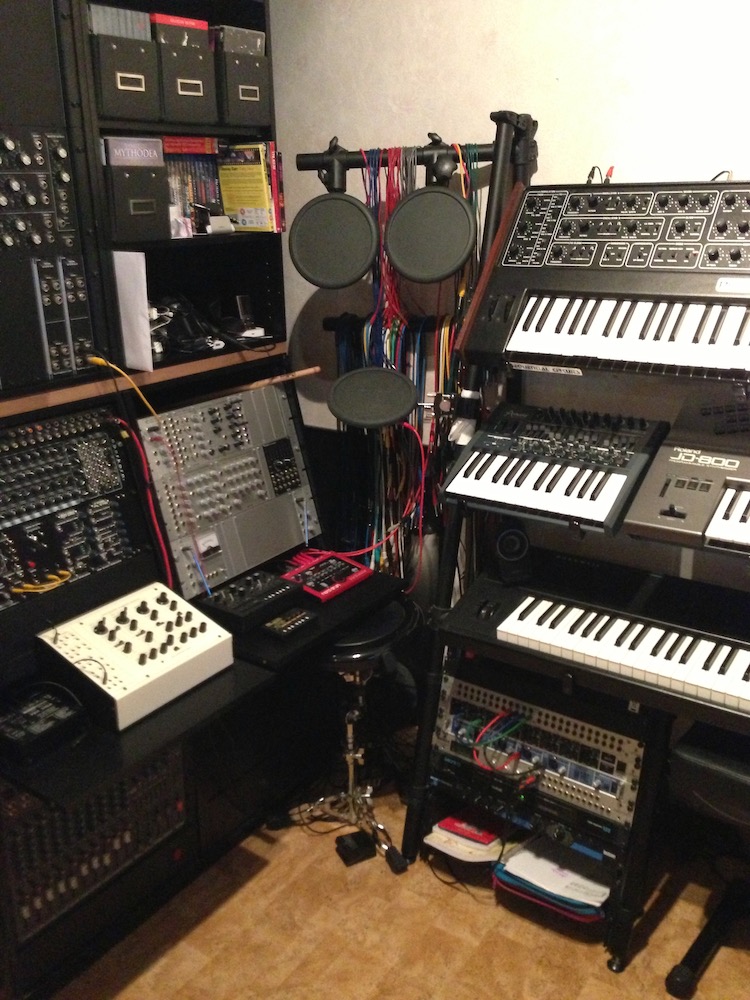
A Corner 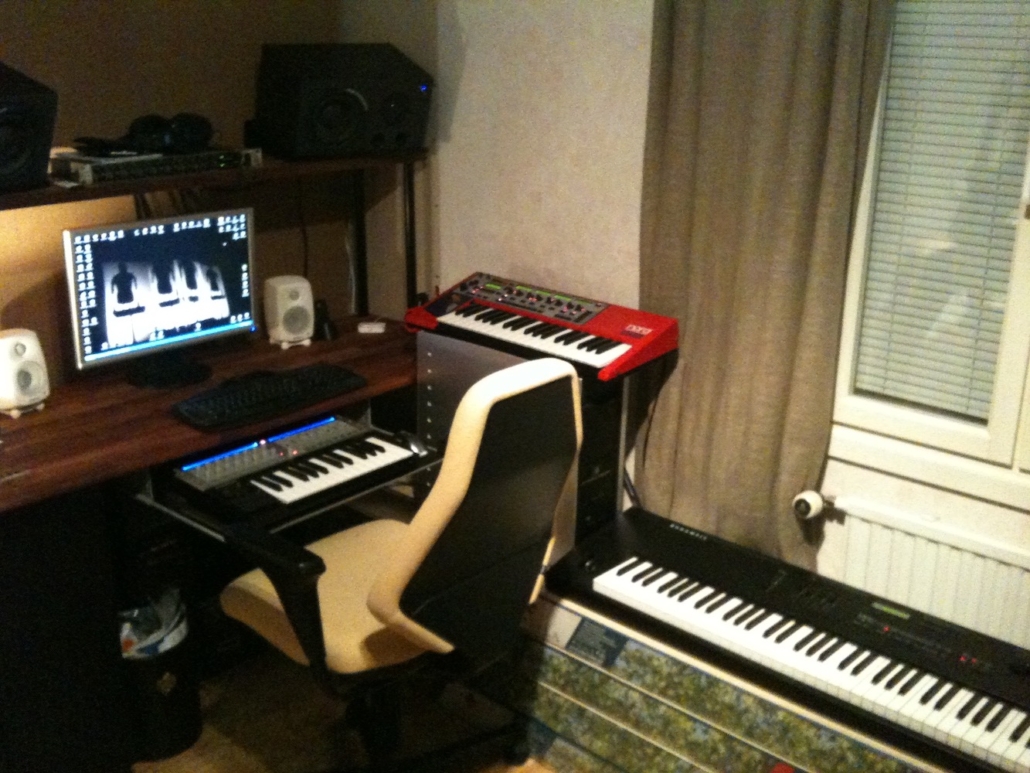
Another Corner 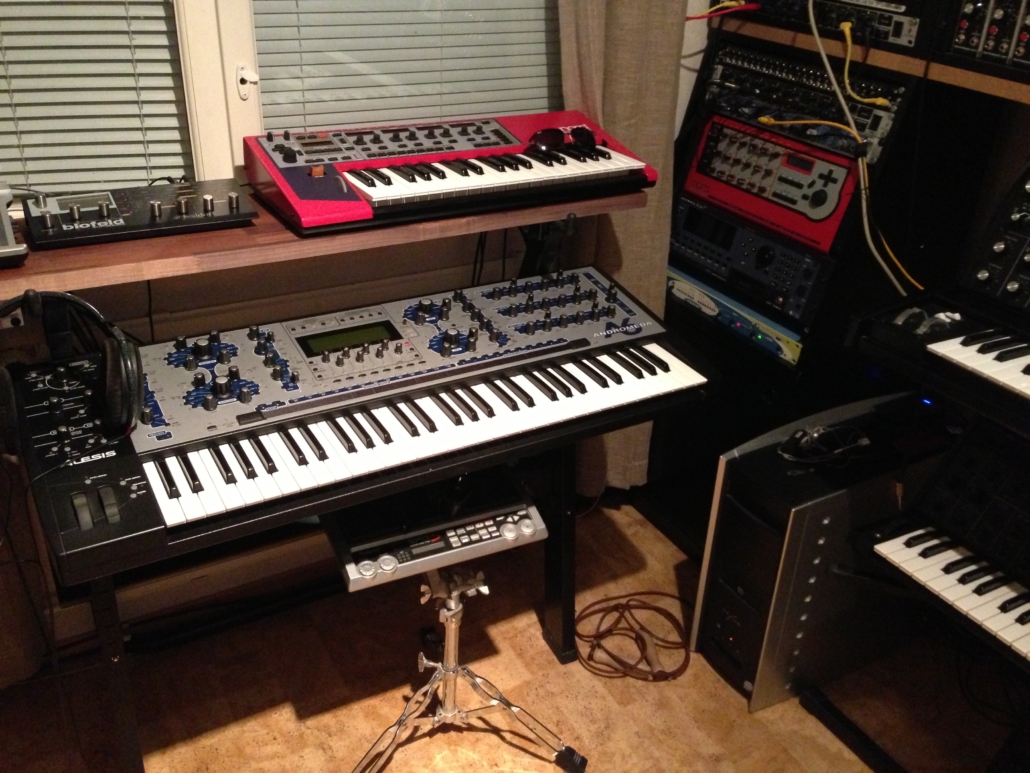
Yet Another Corner, although the same as previously, but at a different time…
Musical Output From This Period
During the first five years of making and then tweaking Don’t Kill Me More Than Twice I had serious problems with my DAW, Sonar Producer. It would crash without warning several times per evening and more often than not autosave hadn’t had the time to autosave anything. Plus Windows absolutely refused to kill the process once it had crashed; the only way to restart Sonar after a crash was to reboot the machine. Quite the disruption to the workflow. One Saturday night I was so pissed off that I was ready to immediately go out and buy a Mac Pro for my last money (pre trash can era). Since everything was closed on Sunday, I didn’t. And by Monday I had come to my senses. But the thought lingered for two years or so. In 2012 I got myself a MacMini just to try it out a bit. It was cool and all, but I didn’t make the change back then. However, the Sonar problems continued, and in late 2013 I got myself a fully upgraded MacBook Air to seriously try out how it’s done the Apple Way. This time things felt right, and I found myself considering either a new trash can Mac Pro or an iMac. Turned out that the 27″ upgraded iMac’s specs were slightly better for making music than the low end Mac Pro’s, so I ended up getting a really nice iMac in December. And the rest is history. I was totally committed to the Apple ecosystem. I now use Logic (and occasionally play a bit with Ableton Live), and I have not had a single problem.
Works like junan vessa.
And interestingly, Logic is the cheapest DAW I have purchased. A one time 200€ (or so) payment, and a lifetime of free upgrades. I paid some 500€ for Sonar, and then a couple of more hundreds every other year when I upgraded. So Apple being expensive isn’t always the case.

Once we had an actual floor upstairs to put things on, the bed could move up there, and the gear could move from the basement to the to-be-studio room, which was partially pulled apart, plus it also served as storage space for uninstalled floorboards and such. So everything was still pretty raw, but somehow it all worked. Everything was compactly laid out an well within reach. It looked like a total mess, but worked very well.
I felt I really needed a drum machine. I wanted to program insane beats. So I got the Jomox XBase 888, which was quite a solid thing. I immediately learned that (as with with the Machinedrum), I really didn’t want to program insane beats with a drum machine, but preferred to do the sequencing via the DAW and use the drum machine just as a sound source. But still, drum machines are fun, and this one was no exception. To this day I have not been able to program insane beats. Actually, I probably don’t even want to, as I prefer simple drum patterns.
I was also covering Rammstein, so I needed an electric guitar. You just can’t cover Rammstein without one. I decided to get the Line 6 Variax modeling electric guitar (except I already did it earlier without one…and ended up not using it here either due to…er, “technical” problems). An interesting piece of machinery: there’s a switch with which you can select which classic guitar it sounds like. So it can sound like a Fender, a banjo or a 12-string acoustic, among others. Weird but insanely useful. The sound might not fool a guitar enthusiast, but buried in the mix I guess it will be quite hard to spot the difference. And besides, who really cares if it doesn’t sound exactly like a Fender Stratocaster…
Musical Output From This Period
Time for a new house. Also time to rip it apart and rebuild it pretty much from scratch. So my gear got to spend the first year in the basement, distributed over three rooms and connected with long cables. It was actually quite a good year: I also spent a lot of time in the basement, sampling anything and everything that made a noise. Hardwarewise, I was running out of audio ports. So I got an RME FireFace 800 and expanded it with two Behringer ADA8000’s. That should do it for quite some time. It was also time to try out generic MIDI controller keyboards, so I got a small ReMote SL to have directly in front of me.
I learned how to make ugly custom dust covers.

The DAW 
Pile of Synth 
Leftovers 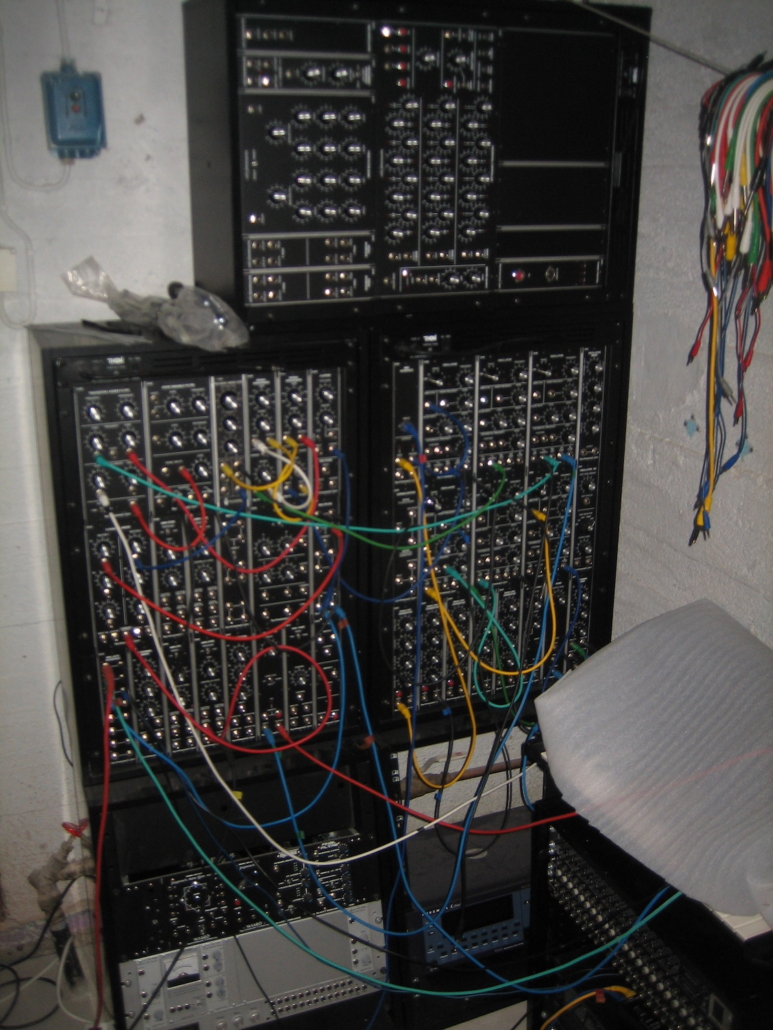
Patched for Don’t Kill Me More Than Twice 
Cable hung-over?
Musical Output From This Period
Sami, my brother, suggested that we should try to make music together. He had a couple of friends who had written him some lyrics, and he had composed melodies to them. So we decided to try it out. Turned out we’d be collaborating for close to 15 years with a bunch of songs he had written at that time. Creating our first song in the basement was hugely athmospheric. I would sample garbage, plastic hoses, tools and basically anything and everything that I found in the basement, and finally we ended up with the song below. It took several years to add the final touches to it (guitars), but other than that, it was born and bred in the basement. Exciting times.
The year pretty much continued as the previous had ended. I was by now an eBay regular. Noteworthy acquisitions for the beginning of the year would be the Waldorf Microwave I, which I bought by accident. I put in an low bid, and ended up winning. I really should do that more often, since every now and then I see that an item I might have wanted, but didn’t bid on because of the price usually being too much, actually had gone for quite a low price. Oh well. One learns.
The studio barely had room for anything more, so I had to build an extra shelf to sit on top of my keyboards in front of me. The shelf didn’t have to sit empty for too long. I decided I would start building a modular synthesizer, and I opted for the Doepfer variety, since they had quite a nice selection of modules, plus the price was right. I thought I’d put it together in a manner previously alien to me: wisely. Meaning one module at a time, and really learning that module before getting a new one. I valiantly ordered an empty 6U case, an oscillator and an LFO and sat down and waited. While I waited, I happened to place the winning bid on an entire full 6U system from eBay. So much for going slowly. Even the “wisely” become quite questionable, as I almost immediately sold the thing to afford a slightly bigger modular, as a part of a larger facelift in the studio, described below.
As a computer can’t by definition provide me an analog signal path, and as digital synths can by nature be replaced by software, I decided that my gear henceforth would consist of analog synths (which would also by necessity have a “good” user interface), and the digital ones would either be replaced by software, or just dumped, unless there was a good reason not to. So the virus, Machinedrum and Microwave had to go. The K2600, JD-800 and Nord Modular stayed, however. Also, since the BassStation only served as a MIDI-CV -interface for the Odyssey, that one had to go as well, but only after I had bought a Doepfer MCV-24 interface to replace it, and to provide further ports for stuff to come.

The Doepfer modular, while nice and all that, was really, ahem, ugly. I did not want to end up with a wall of something I simply don’t want to look at, so I decided to focus around some other manufacturer instead. The fact that the mini-jacks felt flimsy and unreliable and that the small module size felt crammed and unergonomic are also factors. Quite a few times, with my hand deep inside the patchcord spaghetti, I pulled out a patch cord by mistake, only to have absolutely no idea where it came from. Oh well. One learns.
I chose Synthesizers.com. I sold a total of 22 rack units of stuff, and got some of them good ole Texas dotcom modules, and oh boy was it worth it!
There is something magical about a large modular. There is also something childishly fun about patching in all your other analogs into it; for example, using LFO’s and envelopes to control the filters of the MS-20, Odyssey or Pro One. All of my previously acquired analogs benefit from the modular, and it’s just a completely new world to me, and I’m absolutely thrilled. MIDI was never this fun.
CV is pretty hardcore.
Musical Output From This Period
Soft synths don’t force you to rearrange your studio whenever you buy a new one. This fact alone did not keep me from getting new hardware during 2004 instead of focusing all my energy on the admittedly handy soft synths. This proved to be a hardware-intense year. Think Close Encounters of the Analog kind.
It started moderately; I gave in to Alesis-specific gear lust, and got me an Andromeda (ok, forget that about moderately) as well as the M1 mkII active monitors, in order to eliminate the extra stage of noise (old amp/receiver) from between the mixer and the monitors. Good move. Audible difference. The studio appearance didn’t change too drastically yet. During the summer I discovered eBay, and things were never the same. A bunch of analog gear, vintage and more modern, found their way into my studio, some with a little help from my friends (guys, you know who you are). To pay for these, I let my e-drums as well as some other stuff go, simply because I hadn’t used them enough to justify keeping them. Plus, they occupied an entire corner, a place which my gf had other plans for.
As I had decided that it was the year of the Soft Synths, I did not forget them. I tried several, including a “demo” version of the Oddity, which resulted in me getting the original ARP Odyssey. So who was it who said that soft synths were cheap? Well, I purchased both the impOSCar and the M-Tron, so if there is a pattern to be found, both an OSCar and a Mellotron will show up some day, probably much to my gf’s annoyance. The soft synths are really great, handy and extremely usable, but they are Just Not The Same As Hardware. A third soft synth to set its bits on my hard drive surface was the PPG Wave 2.V. I also saw a few real PPG Wave on eBay.
Other stuff I got this year was the Sequential Circuits Pro-One, Korg MS-20 (which actually started the eBay analog revolution), a Novation BassStation and a Studio Electronics SE-1. And a few MIDI to CV converters.
I learned that I am definitely a hardware kind of guy, and that there’s no fighting it. I also learned that I am not fanatically against software, which I think is a good thing.
Musical Output From This Period
By this time, 10 years have passed since I got my first Korg. During 2003, several items both entered and exited my studio. Buying and selling was almost getting to be a habit.
My gf and I bought a house (or part of one), and moved in february 2003. Before moving, I sold my Jerker to my brother, as I had decided I didn’t want a desk in the traditional sense, but I would instead try to build a studio which by its design would keep my focus on making music, as comfortably as possible (without spending additional money, though).
I placed the two racks on top of each other for maximum reachability from my chair. By not having a desk, I was able to rectifiy another inconvenience from most previous studio configurations: I could place the monitors on each side of the keyboard. No more turning my head to hear the stereo sound of what I was playing. It was always about having either the PC monitor or the musical keyboard in front of me, and the PC monitor always won, until now. The PC monitor I now placed on the Spirit monitor, to my left, which was suboptimal but I could live with it. I learned something about sitting in a forward-leaning position while surfing the net.
It quite quickly became apparent that the Obie wasn’t going to cut it as a master keyboard. It was an excellent MIDI controller, but four octaves felt somewhat constrained. I found a second-hand 88 key controller, the Kurzweil PC-88, which really made up for not having been able to upgrade the rack version a year earlier. My first QuikLok rack functioned as a surrogate keyboard stand for a while, but very quickly I got a two-tier QuikLok stand for both my keyboards. I mounted a board in front of the Kurz for my computer keyboard and mouse, and things worked pretty smoothly. I soon reinstated my other keyboard stand and mounted another board on the upper QuikLok tier, onto which I placed the screen. Sitting straight again.

The summer of 2003 brought with it one notable acquisition: my first drum machine, the Elektron Machinedrum. I also got an additional audio patch bay (I had one previously, but didn’t really use it), and did some recabling to get a more flexible signal path. By the end of summer, I traded my Obie for a Roland JD-800.
Now I had “too much” stuff, and I had to buy an additional mixer. I got a cheap Behringer RX 16/02, even though I’ve read mostly bad reviews about the Behringer brand in general. Then my PC broke down, so I had to get a new one. New ones don’t have ISA slots anymore, so my 4×4 MIDI internal interface was useless, and I had to get a MIDI interface as well. I got the MidiSport 8×8, and I’m pretty happy with it. Now, hopefully, I don’t have to get anything else just to keep things working.
Musical Output From This Period
This period turned out to be quite heavily gear-oriented.
Come late 2000, and it was again time to move to a larger apartment. The new additional room became dedicated to my home studio. The Jerker setup travelled with me more or less in its original form, and I just planted it in its new environment.
I turned radical and started to sell gear I didn’t use anymore. In the late 2000 and early 2001, I got rid of both the Roland JX-1 (with some hesitation) and the Octapad.
During the spring of 2001 I started to feel some GAS (Gear Acquisition Syndrome) building up. For a long time I considered getting a Waldorf MicroQ to use as a multitimbral VA to complement the Modular, but I ended up getting a Kurzweil K2600R instead. Not the obvious alternative, but it proved to be a decision not to regret. My rack was pretty crammed by now, so I got two 18U racks and put everything from the QuikLok (synths, mixer, Lexicon) as well as the Jerker contents (PC, home stereo equipment) in them. Having absolutely everything in the two racks fixed the Cable Hell problem very nicely, and for the first time in years, everything looked quite tidy. I had no need for the full-sized Jerker anymore, so I dismounted the two topmost levels.
By now, I was definitely hooked on machines. It wasn’t as bad as getting stuff just for the sake of it; I still tried to maintain some reason behind the purchases. Having used the Modular for a few years already, I had developed an interest in real analog machines, and I had had my eyes on a Waldorf Pulse for some time. In early 2002 I finally got one. Another decision not to regret. This machine moves walls.
The Akai had by now been reduced more or less to a hard disk recording device, and since getting the Kurz, I had no need for the Akai as a musical instrument. When it occurred to me that I could connect the Lexicon’s S/PDIF out to the Digital CD in on the SoundBlaster Live and use the Lexicon as a digital HD recording interface, the Akai was left completely without a job. I soon sold the Akai and a bunch of other useless stuff, and got enough money to get an electronic drum set instead. Drumming was something I had always wanted to do. It still is. I learned something about having too little time to use all the gear I had collected.
I was starting to consider getting rid of the Emax (with much hesitation), as I had neither used its sound nor its mixer capabilities, and I felt it was such a waste to use it merely as a controller. My plan was to sell the Emax, by now my only keyboard, and swap the Kurzweil 2600R for the 88-key version, and hopefully be set for life in the keyboard department. Selling the Emax appeared to be easy enough, but nobody was interested in getting rid of their K2600X’s, and getting a new one was out of the question. I started looking into alternative keyboards, and I figured one with actual sounds wouldn’t be a bad investment. I had become interested in a Virus, the King of VA’s, so I started saving money for the keyboard version, and prepared myself emotionally to part from the Emax. Just before I was going to place an order on a kc, I found another dealer who could provide me with the virus c rack version plus the Oberheim OB-12 VA for a total of about 50 euros less than what I was originally going to spend on the kc. So I felt I was literally getting one extra synth for the same price. The only drawback was that Obie only had four octaves, but I considered that only a minor drawback, all things considered. I ordered the two machines and sold my Emax, which I actually regret a bit, which of course is totally irrational.
Having been without something to drum on for a while, I got a real eDrum set, the Yamaha DTXpress. I learned that drumming is as fun as it is hard.
Musical Output From This Period
After a while I decided to move Jerker (with contents) into the bedroom. Swapping cables to and from the inputs of the Nord Modular and outputs between the different synths made me realize I finally needed a mixer. I bought a mixer, and while I was at it, an external effects unit, the Lexicon MPX 100, as well. I naturally had nowhere to put them, so I got a QuikLok rack, put everything that was rackmountable into it and placed it conveniently next to the Jerker. I learned something about Cable Hell and how much cables gather dust.
My SyQuest media broke down in the middle of a production. The drive itself broke down soon afterwards. I learned the importance of backing up. I eventually replaced the SyQuest with a Zip drive.
In early 1999, I bought a Roland Octapad II, which was nice but too noisy for a block of flats. I decided to sell the Wavestation in early 2000, having not used it as much as I felt I should have. The WS programming had quite a steep learning curve, and I simply didn’t feel inspired by it. I was probably spoiled by the Modular, which was an absolute dream to use. That was the first time I sold a sound source, not really counting the first Korg I had.
Musical Output From This Period
The year 1998 started with me feeling like I wanted a “real” synthesizer and therefore buying a Korg Wavestation SR, which I didn’t know anything about. I also got a pair of Spirit Absolute 2 monitors, which made all the difference in sound compared to the plastic multimedia speakers I had prior to them. It became apparent that radical furniture rearrangement was called for. I split the livingroom into two distinct parts, one for usual livingroom stuff, and the other for my Home Studio, which I now felt totally comfortable calling it. I invested in an IKEA Jerker desk, which is really handy for a setup like mine. Jerker hosted everything except the keyboards, so everything was nicely within reach.
The year 1998 ended with me buying a Nord Modular. I got an amazing deal for a new unit, 30% off the list price, and I took a bank loan to pay for it, which is something I had never done before, nor since. The Modular changed my perception of how a synth should work. It stood for everything I always liked in electronic music, and I probably couldn’t have made a better choice at that time. I learned a lot about subtractive synthesis. Among other things.
I managed without a mixer quite nicely, even with this many sound sources, as the Emax performed mixer duties with its numerous inserts.
Sadly, no pictures exist of that setup. But it was right there, I promise!
Musical Output From This Period
Eventually I moved to a bigger apartment. With one additional room at my disposal, I thought I could invest in a modular system. Or maybe a sound module? I don’t think I could tell the difference in those days.
That little barely visible Roland SC-88 in the right-hand side lower corner, next to the JX-1, is what I bought in late 1995. Both Rolands had practically zero learning curve, so I was quite lucky in that aspect. The SC mostly used cc’s for controlling various things (mostly reverb and chorus), but the real news came in the shape of NRPNs, which it used for envelope and filter settings. I thought it was pretty hardcore.
The keyboard was situated behind me, as I couldn’t comfortably place it on my desk. The newly acquired SC didn’t really change the appearance of my still-not-referred-to-as-a-studio. This is not true for the Emax II and the Akai S2000, which I bought just a few days apart, in early 1997. This was also the first time when getting something new necessitated getting something else: now I had to buy a MIDI interface to get all the machines connected to my PC. I got a MIDIMan 4×4, and I had it for 7 years and it worked like a dream.
Getting the samplers made me rethink my furniture arrangement, and I ended up getting a two-tier X-stand for the Emax and the JX-1, and placing the Akai underneath my monitor. I also ditched the small plastic speakers, and got bigger plastic speakers instead. The gear still only occupied one corner of my living room. The actual corner varied somewhat during the years, but the idea remained the same. The setup started to become noticably different from standard living room equipment, and I almost felt like calling it a home studio. During this period, I also got an external 135 MB SyQuest drive for storing samples for the Akai. I learned a lot about sampling. I also got introduced to filters and LFO’s, which was way more hardcore than anything else previously.
Sadly, no pictures exist of that setup.
Musical Output From This Period
Getting my first PC (a 386) seriously re-introduced me to sequencer software (my first seq was WinJammer, if I recall) and music programming, something which had laid dormant in me for almost ten years. After getting my first MIDI keyboard, the Roland JX-1, I gave it a permanent home on my desk. During this time, I learned something about SysEx, as used by the JX-1 to receive and transmit slider values. I thought it was pretty hardcore. I invested in small plastic battery-driven PC loudspeakers. Active monitors, as it were. Sadly, no pictures exist of that setup, but you’re not really missing out on much. This next paragraph is from elsewhere on this site, but it’s worth repeating in context: Late one night in 1993, while studying for an exam the following day, it occurred to me that composing was basically just a matter of putting notes in an order which sounded pleasing, and to surround them with even more notes in another pleasing order. So I skipped studying that night and wrote/produced my first song ever, from start to finish, following the by then very familiar Depeche Mode song structure. After the exam (which I, amazingly, passed, even though not having slept the night before), I went home, pulled another allnighter and sequenced my second song, went to bed, slept the entire following day and got up and immediately produced my third one. Needless to say, I was hooked and absolutely amazed I had it in me. [Edit 29.11.2021] Yesterday I found the actual exam paper in question, dated 1993-09-03, so I can now happily state that my first song ever was made 1993-09-02. During this period I started close to twenty songs, but they remained in Under Construction-mode for quite some time. Many of them were never finished, but maybe one day… The original versions of my first three tracks have been lost. They are probably on a C-cassette somewhere, as in those days I couldn’t record onto the hard drive. These versions are structurally the same (same individual melodies), but the sounds are different (except for the lead sound the JX-1 makes in each song). The original Gravis Ultrasound sounds have been replaced with SC-88 and Akai S-2000.Musical Output From This Period
It’s a start. Laptop studios sure have evolved since those days. But anyway, there it is, my first synth. A Korg of some sort.
The term studio is far from my mind at this point. But it’s the beginning of it, nonetheless.
No music survived this period.
